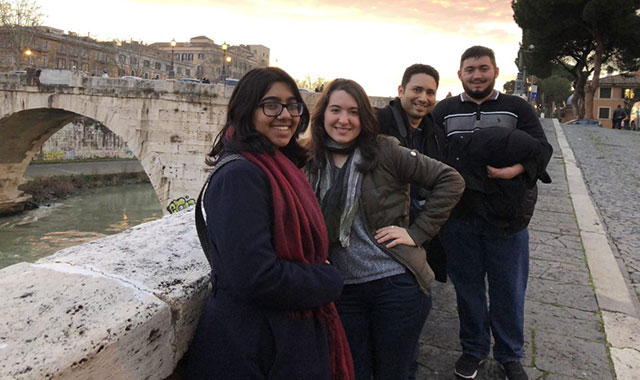Linguistics and Literature
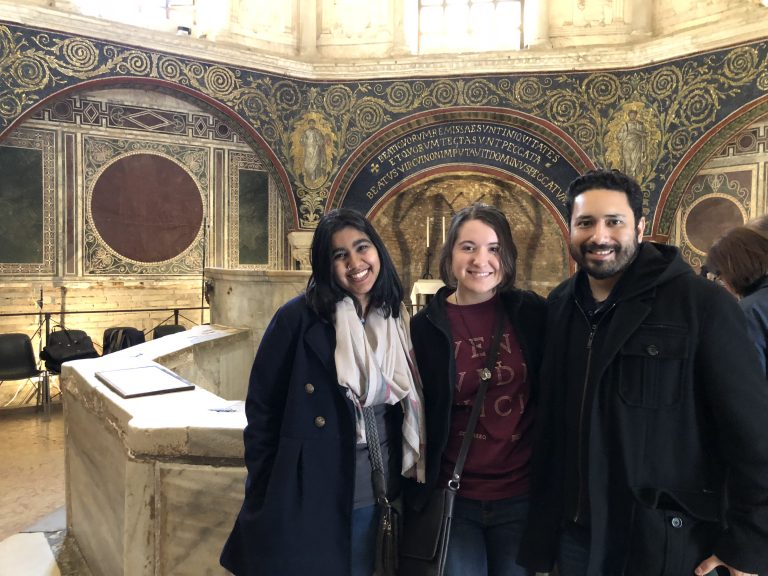 Unlike many study abroad programs, which involve registrations at foreign institutions and administrative hurdles to transfer courses, the COLFA Semester in Urbino offers UTSA courses taught by UTSA faculty or by University of Urbino faculty who have been vetted and approved by UTSA. The courses have been carefully selected to fit into UTSA degree plans and will appear seamlessly in ASAP. Moreover, since you will remain a full-time UTSA student during your semester abroad you will have access to UTSA services such as financial aid and library resources and will not encounter difficulties with minimum credit-hour requirements for financial aid or scholarships.
Unlike many study abroad programs, which involve registrations at foreign institutions and administrative hurdles to transfer courses, the COLFA Semester in Urbino offers UTSA courses taught by UTSA faculty or by University of Urbino faculty who have been vetted and approved by UTSA. The courses have been carefully selected to fit into UTSA degree plans and will appear seamlessly in ASAP. Moreover, since you will remain a full-time UTSA student during your semester abroad you will have access to UTSA services such as financial aid and library resources and will not encounter difficulties with minimum credit-hour requirements for financial aid or scholarships.
Supplemental art and cooking classes are also available during the semester
If you want to get a head start on Italian language so that you can enroll in the advanced class in Urbino, try the Italian Language and Culture class on edX. It is all online and you can audit for free!
Important Dates for Spring 2022
See some of the important events and trips scheduled for the semester. Many of the details are still being finalized, so some dates and trip destinations may vary. A printable schedule with class meeting times is also available. Consult the Spring 2022 Timeline for meetings, payments, and scholarship deadlines.
| August 27 | List of participating students finalized |
|---|---|
| October 1 | $1000 commitment fee due |
| November 1 | $1750 balance of first payment due (remaining payments will be invoiced in ASAP and due on January 15, February 15, and March 15) |
| January 29 | students arrive in Italy (either G. Marconi Airport in Bologna (BLQ) or Leonardo da Vinci International Airport in Fiumicino, Rome (FCO): the location is still TBD) no later than 1:30; charter bus to Urbino arrives at 2:30 and departs no later than 3:00. Anticipated arrival in Urbino at 5:30. |
| January 30 | 9:00 GEV Orientation 1:00 Welcome lunch 3:00 Urbino tour |
| January 31 | Classes begin. We will meet in front of the Collegio Internazionale and walk together to meet the Italian language teachers |
| February 4 | Guided tour of Pesaro (public bus) including Rossini's birth house, Civic Museum, and historic fish market |
| February 6 | 9:30 guided tours of the Ducal Palace in Urbino and historic Urbino |
| February 10 | day trip to Bologna |
| February 11 | Guided tour of the Girolomoni organic pasta factory and the Il Conventino winery and olive production mill |
| February 17-20 | Rome |
| February 24 | day trip to Perugia |
| March 3 | day trip to Assisi |
| March 10-13 | Siena and Florence |
| March 14-20 | Urbino Spring Break |
| March 24 | day trip to Gubbio |
| March 31-April 3 | Verona and Venice |
| April 6 | Ceremony and Concert in observance of the 502nd Anniversary of the Death of Raffaello |
| April 7-9 | Linguistics Colloquium |
| April 14 | day trip to Ravenna |
| April 14-18 | Easter Break (no classes) |
| April 25 | Liberation Day Procession and Concert |
| April 26 | Final Exams, Papers & Projects; Farewell dinner |
| April 27 | Final Exams, Papers, & Projects Studio cleaning & check out |
| April 28 | Early Departure Bus to Rome 5 am (also one at midnight for those with early flights). All studies must depart from Italy on this day |
Course Information
The following 16 credit hours of courses are offered during the Spring 2022 semester. The focus will be especially relevant to students in the English, Modern Language Studies, Communication, and History programs, and will provide two of the four required courses for the Linguistics minor. The two linguistics courses will also fulfill requirements for students seeking teaching certification in English. Graduate versions of these courses are also available. If you are a graduate student interested in the COLFA Semester in Urbino, please contact us for more information.
| ENG 3323/LNG 3813/ENG 6033 | Excavating Language |
|---|---|
| ENG 3343/LNG 3813/ANT 3903/ENG 6033 | Language and Religion in Europe and Beyond |
| CSH 3023/ITL 3023 | Advanced Topics in World Cultures |
| AHC 4333 | Medieval and Renaissance Art History |
| FL 1034 | Elementary Italian |
Course Descriptions
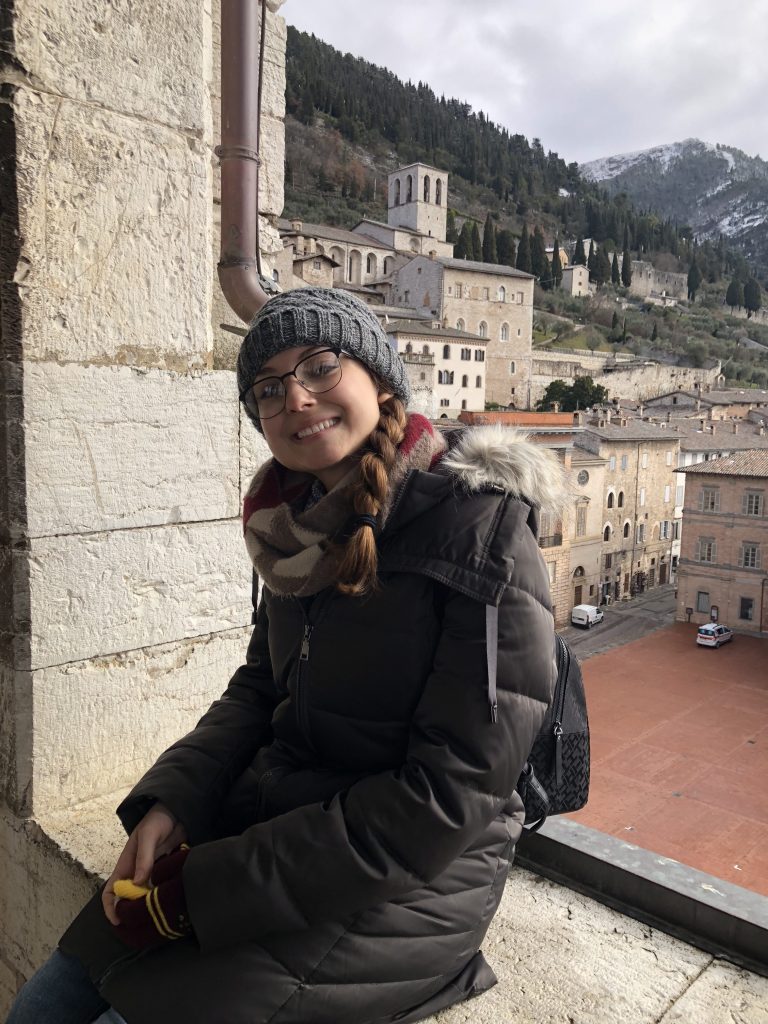 ENG 3323/LNG 3813/ENG 6033 Excavating Language: Linguistic Connections across Latin, Italian, and English. In this course we will explore the linguistic influence that Latin and Italian have exerted on English through the centuries, as well as the recent influence that English has had on Italian. We will begin with an examination of the Proto-Indo-European roots of both the Italic and the Germanic languages, and what the two language families share because of their common heritage. We will examine the archaic layers of Latin and its “cousin”, Umbrian, spoken in territories near to Urbino in ancient times, and will visit the most notable site of the Umbrian language, Gubbio (Iguvium), where a number of ancient bronze tablets were found. We will proceed to study the linguistic effect of the spread of the Roman Empire, the role of Christianity in the diffusion of particular trends, and the linguistic implications of the decline of Roman influence and increase in the role of Germanic tribes such as the Goths and the Franks. We will then focus on the influence that the Romance languages and Latin itself had on the Germanic languages, and English, specifically, during late medieval and Renaissance times. We will examine Shakespeare’s Romeo and Juliet for its linguistic content, particularly the influence of Latin on Shakespeare’s language. W e will end with a look at how Italian, French, and Spanish developed from Latin, and the influence that these Romance languages have exerted on English in recent years.
ENG 3323/LNG 3813/ENG 6033 Excavating Language: Linguistic Connections across Latin, Italian, and English. In this course we will explore the linguistic influence that Latin and Italian have exerted on English through the centuries, as well as the recent influence that English has had on Italian. We will begin with an examination of the Proto-Indo-European roots of both the Italic and the Germanic languages, and what the two language families share because of their common heritage. We will examine the archaic layers of Latin and its “cousin”, Umbrian, spoken in territories near to Urbino in ancient times, and will visit the most notable site of the Umbrian language, Gubbio (Iguvium), where a number of ancient bronze tablets were found. We will proceed to study the linguistic effect of the spread of the Roman Empire, the role of Christianity in the diffusion of particular trends, and the linguistic implications of the decline of Roman influence and increase in the role of Germanic tribes such as the Goths and the Franks. We will then focus on the influence that the Romance languages and Latin itself had on the Germanic languages, and English, specifically, during late medieval and Renaissance times. We will examine Shakespeare’s Romeo and Juliet for its linguistic content, particularly the influence of Latin on Shakespeare’s language. W e will end with a look at how Italian, French, and Spanish developed from Latin, and the influence that these Romance languages have exerted on English in recent years.
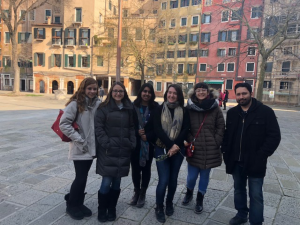 ENG 3343/LNG 3813/ENG 6033 Language and Religion in Europe and Beyond . In this course we will explore the mutual influences of religion and language throughout history, with special focus on Europe. Most religious practices and beliefs entered Europe from elsewhere, so it will be our task to explore these ancient sources and how they are tied to linguistic innovations and trends on the European continent. We will begin with an examination of the Proto-Indo-European roots which can inform us about the existence of beliefs, rituals, oaths, prayers, and omens of our ancient linguistic ancestors. We will proceed to examine how these practices developed in Greek and Roman settings, as well as in Umbria, a territory located near to Urbino . We will then visit the most notable site of the Umbrian language, Gubbio ( Iguvium ), and the ancient bronze tablets preserved there which recount the laws an d religious practices of the At i e dian brothers. We will examine how the coming of Christianity to the Roman Empire affected and was affected by language, and will examine the Sacral Stamp of Greek in some detail—the influence of Greek lexicon, syntax, and style on the translations of the Bible into Latin, Gothic, and Old Church Slavonic. We will then trace the important interconnected roles of Hebrew and Judaism by examining texts and translations, and will study how Hebrew, as translated into Greek in the Septuagint, served as a model for particular stylistic and syntactic features of the New Testament. We will proceed to study the role that Arabic and Islam played in Europe, especially in the Iberian Peninsula, and will examine the evidence that persists in Spain and Portugal to the present day, in architecture, art, and language. Next, we will study the rise of Orthodoxy in Eastern Europe, and the contrasts which arose in eastern and western Europe due to the two contrasting “roofs” of Greek Orthodoxy and Ro man Catholicism. Finally , we will examine the Protestant Reformation and its role in shaping the language s of Europe, as well as the Counter-Reformation and the Inquisition that followed.
ENG 3343/LNG 3813/ENG 6033 Language and Religion in Europe and Beyond . In this course we will explore the mutual influences of religion and language throughout history, with special focus on Europe. Most religious practices and beliefs entered Europe from elsewhere, so it will be our task to explore these ancient sources and how they are tied to linguistic innovations and trends on the European continent. We will begin with an examination of the Proto-Indo-European roots which can inform us about the existence of beliefs, rituals, oaths, prayers, and omens of our ancient linguistic ancestors. We will proceed to examine how these practices developed in Greek and Roman settings, as well as in Umbria, a territory located near to Urbino . We will then visit the most notable site of the Umbrian language, Gubbio ( Iguvium ), and the ancient bronze tablets preserved there which recount the laws an d religious practices of the At i e dian brothers. We will examine how the coming of Christianity to the Roman Empire affected and was affected by language, and will examine the Sacral Stamp of Greek in some detail—the influence of Greek lexicon, syntax, and style on the translations of the Bible into Latin, Gothic, and Old Church Slavonic. We will then trace the important interconnected roles of Hebrew and Judaism by examining texts and translations, and will study how Hebrew, as translated into Greek in the Septuagint, served as a model for particular stylistic and syntactic features of the New Testament. We will proceed to study the role that Arabic and Islam played in Europe, especially in the Iberian Peninsula, and will examine the evidence that persists in Spain and Portugal to the present day, in architecture, art, and language. Next, we will study the rise of Orthodoxy in Eastern Europe, and the contrasts which arose in eastern and western Europe due to the two contrasting “roofs” of Greek Orthodoxy and Ro man Catholicism. Finally , we will examine the Protestant Reformation and its role in shaping the language s of Europe, as well as the Counter-Reformation and the Inquisition that followed.
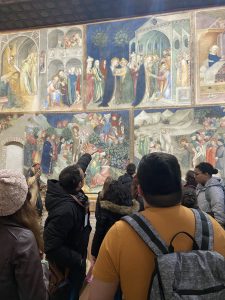 CSH 3023/ITL 3023 Advanced Topics in World Cultures: Dante, Petrarca, e Boccaccio: Love and Death in the Italian Renaissance. This course will examine the way in which the literature and visual arts of the Italian Renaissance confront the perennial pairing of the themes of love and death. Our aim will be to understand what love and death meant for this particular community in an effort to determine why these two themes were constantly intertwined in its literature, as well as in the visual arts. We will begin with an introduction of the poetry of the early stilnovists (the group of poets identified with “the sweet new style”), primarily Guinizzelli and Cavalcanti, and continue with their legacy as witnessed in the literary and visual art of Dante, Petrarch, Boccaccio, Michelangelo, Botticelli, Titian, Simone Martini, Raffaello Sanzio and Machiavelli. Our project will be to read the material and to look at the art critically, not descriptively. We will assess the importance of these two themes, love and death, in the works under consideration in order to determine why they appeared together over and over again. Ultimately, our focus will be to decide whether earthly love was considered possible in this cultural milieu without the notion of the inevitability of death looming on the horizon. Most of the reading will be available to you in both English and Italian or Latin, although no prior knowledge of Italian or Latin is required. Over the course of the semester, you will visit museums in Urbino, Florence, Siena, Rome, Ravenna and Venice, among others, to look at works of art that may have inspired our readings, or been inspired by them.
CSH 3023/ITL 3023 Advanced Topics in World Cultures: Dante, Petrarca, e Boccaccio: Love and Death in the Italian Renaissance. This course will examine the way in which the literature and visual arts of the Italian Renaissance confront the perennial pairing of the themes of love and death. Our aim will be to understand what love and death meant for this particular community in an effort to determine why these two themes were constantly intertwined in its literature, as well as in the visual arts. We will begin with an introduction of the poetry of the early stilnovists (the group of poets identified with “the sweet new style”), primarily Guinizzelli and Cavalcanti, and continue with their legacy as witnessed in the literary and visual art of Dante, Petrarch, Boccaccio, Michelangelo, Botticelli, Titian, Simone Martini, Raffaello Sanzio and Machiavelli. Our project will be to read the material and to look at the art critically, not descriptively. We will assess the importance of these two themes, love and death, in the works under consideration in order to determine why they appeared together over and over again. Ultimately, our focus will be to decide whether earthly love was considered possible in this cultural milieu without the notion of the inevitability of death looming on the horizon. Most of the reading will be available to you in both English and Italian or Latin, although no prior knowledge of Italian or Latin is required. Over the course of the semester, you will visit museums in Urbino, Florence, Siena, Rome, Ravenna and Venice, among others, to look at works of art that may have inspired our readings, or been inspired by them.
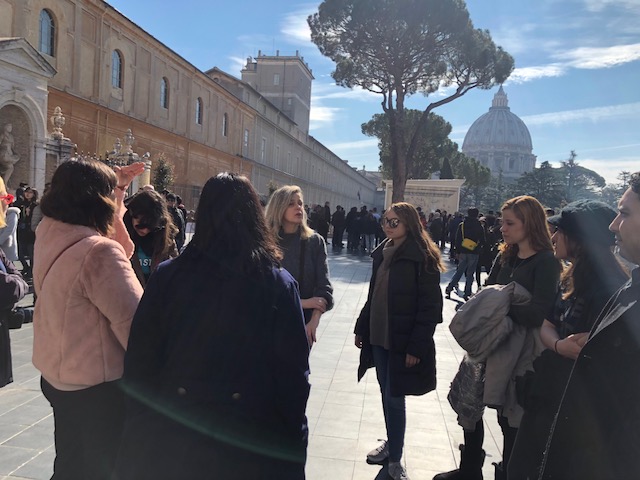 AHC 4333 Medieval and Renaissance Art History. In this course we will investigate several aspects of Medieval and Renaissance Art that took place in Italy during the 13th-16th centuries. We will begin with a short examination of the transition from Greek-Roman Art to the Art of the Middle Ages and the transition from Medieval Art (with a focus on gothic or proto-Renaissance art) to Renaissance Art, in order to be able to make critical comparisons between artworks from different ages. We will focus on architecture, sculpture and painting with an emphasis on monuments and works of art which students will see during the semester.
AHC 4333 Medieval and Renaissance Art History. In this course we will investigate several aspects of Medieval and Renaissance Art that took place in Italy during the 13th-16th centuries. We will begin with a short examination of the transition from Greek-Roman Art to the Art of the Middle Ages and the transition from Medieval Art (with a focus on gothic or proto-Renaissance art) to Renaissance Art, in order to be able to make critical comparisons between artworks from different ages. We will focus on architecture, sculpture and painting with an emphasis on monuments and works of art which students will see during the semester.
FL 1034. Beginning Language Study Abroad. Opportunity to begin developing oral and written communication skills in the target language, along with enhanced comprehension skills in listening and reading. Linguistic and cultural immersion. May be repeated up to 8 semester credit hours in each language.
Spring 2020 Faculty
Dr. Bridget Drinka is a Professor of Linguistics in the Department of English and Co-Director, with Dr. Drew Stephen, of the COLFA Semester in Urbino . She received her Ph.D. from the University of Texas at Austin, specializing in Indo-European and historical linguistics. As a member of the UTSA faculty since 1991, her research has focused on such issues as the sociolinguistic motivations for language change, the role of contact in linguistic innovation, and the importance of geographical contiguity in the diffusion of changes across the Indo-European languages. Her 2017 book, Language Contact in Europe: The Periphrastic Perfect through History (Cambridge University Press), explores the complex development of a grammatical category as it spread across the map of Europe. The book was awarded the Leonard Bloomfield Book Award for 2019 by the Linguistic Society of America. Dr. Drinka’s interest in international education reaches back to her own undergraduate days, when she participated in a Semester Abroad in Florence, Italy. A Fulbright Senior Lecturer at Moscow State University in 1998 and visiting professor in Germany, Italy, and Japan, she served from 2015-17 as President of the International Society for Historical Linguistics, and was responsible for organizing the Society’s 2017 meeting, the International Conference on Historical Linguistics 23. She was also recipient of the University of Texas Chancellor’s Council Outstanding Teaching Award in 1999, and the Richard S. Howe Outstanding Undergraduate Teaching Award in Spring 2016. The courses that Dr. Drinka teaches in Urbino , “Excavating Language” and “Language and Religion”, are both designed to bring her own expertise in historical linguistics to her students, while enabling them to have a rich semester-abroad experience, visiting the monuments and artifacts t hat they will be studying.
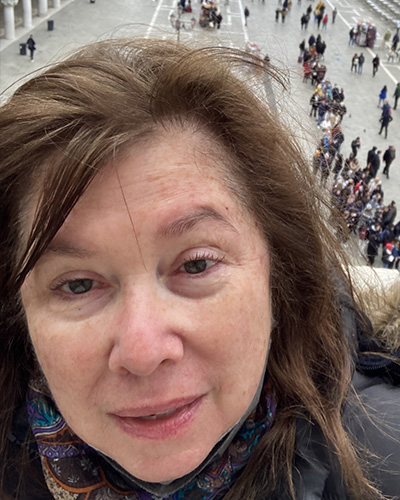 Dr. Molly Mezzetti Zaldivar has served as coordinator of Italian Language and Culture Studies in the Department of Modern Languages and Literatures at UTSA since 1999. In the Spring semester 2012, she began teaching for COLFA in Urbino, and has since been back in both 2014 and 2016. In addition to teaching for COLFA, she has developed a pre-departure program for students of Architecture, Lezioni italiane, in order to help curb their cultural / linguistic shock. In Urbino, Molly has taught courses on the 3 crowns of Italian literature, Dante, Petrarch and Boccaccio, as well as a Theatre workshop. Her research encompasses topics ranging from medieval Italian literature to 21 st Century Italian cinema.
Dr. Molly Mezzetti Zaldivar has served as coordinator of Italian Language and Culture Studies in the Department of Modern Languages and Literatures at UTSA since 1999. In the Spring semester 2012, she began teaching for COLFA in Urbino, and has since been back in both 2014 and 2016. In addition to teaching for COLFA, she has developed a pre-departure program for students of Architecture, Lezioni italiane, in order to help curb their cultural / linguistic shock. In Urbino, Molly has taught courses on the 3 crowns of Italian literature, Dante, Petrarch and Boccaccio, as well as a Theatre workshop. Her research encompasses topics ranging from medieval Italian literature to 21 st Century Italian cinema.
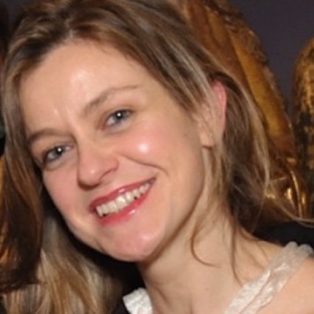 Dr. Grazia Fachechi is an Assistant Professor of Art History at the University of Urbino, Department of Humanities, where she has taught undergraduate and graduate students for more than twenty years. She received her Bachelor and Master degrees in Urbino and did post-graduate work in other cities: Florence (certificate in Museology and Art Criticism at the International University of Art – UIA), Perugia (PhD in Art History at the University of Perugia) and Rome (Diploma of Specialization in Medieval and Modern Art History at Sapienza University). She currently lives in Rome.
Dr. Grazia Fachechi is an Assistant Professor of Art History at the University of Urbino, Department of Humanities, where she has taught undergraduate and graduate students for more than twenty years. She received her Bachelor and Master degrees in Urbino and did post-graduate work in other cities: Florence (certificate in Museology and Art Criticism at the International University of Art – UIA), Perugia (PhD in Art History at the University of Perugia) and Rome (Diploma of Specialization in Medieval and Modern Art History at Sapienza University). She currently lives in Rome.
Dr. Fachechi’s principal fields of expertise are illuminated manuscripts (specifically works preserved in the Vatican Library) and wooden sculptures. She is the author of a book on Jacopo da Fabriano who was one of the favorite miniaturists of the Renaissance Pope Pius II and two books on wooden sculptures. The most recent is a catalogue of the most important wooden sculpture collection in Italy (housed in the National Museum of Palazzo Venezia in Rome) and was funded by the Getty Foundation of Los Angeles.
She has also published research on paintings, both from the Medieval and Renaissance ages. She is very interested in the text-image relationship, both in the religious context, with special regard to the iconography of the Passion of Christ, and in the lay context, with particular interest in iconographical themes of Classical Antiquity and the visual illustration of ancient literary works (especially those by the Latin writers Plauto and Seneca) in the Medieval and Renaissance eras.
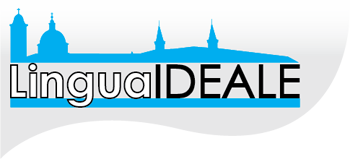 The Italian language courses are taught by certified instructors at Lingua Ideale Urbino working under the auspices of the University of Urbino “Carlo Bo”. Lingua Ideale is a professional language school offering courses of Italian language and culture to foreigners. The curriculum for the COLFA Semester in Urbino has been designed to meet the requirements of the foreign language courses at UTSA while also incorporating local aspects of Italian culture.
The Italian language courses are taught by certified instructors at Lingua Ideale Urbino working under the auspices of the University of Urbino “Carlo Bo”. Lingua Ideale is a professional language school offering courses of Italian language and culture to foreigners. The curriculum for the COLFA Semester in Urbino has been designed to meet the requirements of the foreign language courses at UTSA while also incorporating local aspects of Italian culture.

